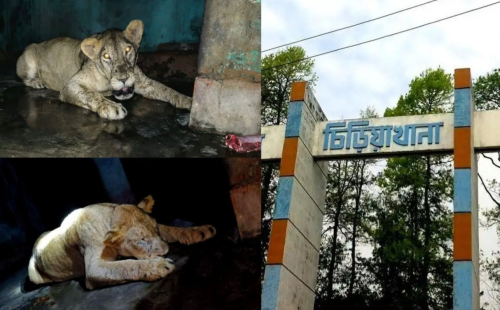The peanut power

Basir Mirza has been selling peanuts for his entire adult
life. At around 3:00 pm every day, he sets up his floating cart in front of the
playground on Manik Mia Avenue near the parliament building, one of Dhaka's
busiest, crowded areas -- a good spot to fetch customers. For nearly four
decades, the trade has rewarded him well, and he never considered trying
anything else.
"Selling peanuts allowed me to pay for my daughter's
education, her wedding, and even buy a small portion of land in my
village," the 55-year-old, hailing from Bhairab of Kishoreganj, said as he
set up his shop.
Unlike vendors of other goods, Mirza's business has been
stable through every political upheaval, economic downturn, and social shift. A
handful of peanuts is always cherished by people everywhere, from the posh
urban towns to the remote villages.
Once a stand-alone street snack, groundnut has grown into a
sought-after crop as food processors diversify its uses in everything from
snacks to confectionery. This rising demand has prompted farmers to expand
cultivation, backed by agri-scientists developing higher-yield varieties. The
result is a gradual surge in production, setting the stage for the next phase
of the oilseed's journey.
Mirza's business captures the timeline partly.
Back in 1988, when a neighbour helped an unemployed Mirza
start out as a peanut seller, his daily earnings ranged between Tk 200 and Tk
300. These days, he earns up to Tk 2,500, with daily profits standing around Tk
800.
Mirza represents hundreds of thousands of people whose life
depends on peanuts and who are making it a growing force for the economy. Their
ecosystem spans the whole of Bangladesh.
A GROWING CASH CROP
Rich in protein, oil, and fibre, the peanut is one of the
country's most popular stand-alone snacks. Its demand has steadily expanded,
thanks in part to its widespread use by food processors. The legume crop is an
ingredient in chanachur, biscuits, bakery items, confectionery, cookies, bars,
cakes, and chocolates. It is turned into butter, mashed into bharta, used in
curries and salads, and even incorporated into skincare products.
This encouraged farmers to cultivate the peanut more, and
so too were the efforts by agri-scientists to develop improved varieties of the
oilseed.
Production, which was around 45,000 tonnes one and a half
decades ago, soared to 1,99,100 tonnes in the fiscal year 2024-25, according to
the Department of Agricultural Extension (DAE).
Over 200 kilometres north of Dhaka, at Islampur upazila in
Jamalpur, farmer Mohammad Kamruzzaman Akand represents the peak of peanut
farming success.
"I started from scratch. Now I own a house in the
municipal area worth about Tk 50 lakh, built entirely from groundnut earnings.
I have also purchased four to five bighas of char land," he said over the
phone.
Further north, in Chilmari upazila of Kurigram, 65-year-old
Nazrul Islam harvested nuts from eight bighas at Joragach char this year.
"Nothing grows well in sandy char soil except peanuts.
For us, this is the crop of hope," he said.
In Kalimati char of Lalmonirhat, another border district,
60-year-old Nurjamal spoke of the crop's value compared with others.
"We turned our fallow land into cultivable land
through this oilseed. It has become our main source of income. If the market
price holds, peanuts are far more profitable than other crops," he said.
Data from the Bangladesh Bureau of Statistics shows
wholesale peanut prices more than doubled to over Tk 160 per kg in 2024, up
from Tk 62 in 2011.
IT GROWS WHERE NOTHING ELSE DOES
Peanut cultivation in Bangladesh began in the mid-20th
century, and production has since expanded significantly.
Government officials say the main driver of the peanut's
expansion is its unique ability to grow in fallow lands, especially the chars
or sandy riverine islands.
"Peanut is drought-resistant and thrives in sandy and
loamy soil. Since char lands do not hold water, yields are usually very
good," said Abdullah Al Mamun, deputy director of the DAE in Kurigram.
Mohammad Quamrul Islam Matin, senior scientific officer at
the Oilseeds Research Centre (ORC) under the Bangladesh Agricultural Research
Institute (BARI), added that farmers are steadily expanding cultivation in char
areas where land availability and favourable conditions make it viable.
According to SM Sohrab Uddin, director of the DAE's
Horticulture Wing, peanuts are now grown in nearly all districts except
Meherpur, Dinajpur, and Joypurhat. The northern region alone accounts for
nearly one-third of production, thanks to its vast chars. Once a marginal crop,
peanuts are now central to the rural economy here.
Sirajul Islam, additional director of the Rangpur DAE,
identifies Lalmonirhat, Kurigram, Gaibandha, Rangpur, and Nilphamari as the key
peanut-growing districts. "Vast areas along the Teesta, Brahmaputra,
Dudhkumar, and Dharla rivers are now peanut fields."
Nearly 90 percent of the output comes from 650 chars.
About 70 percent of domestic production now comes from
Noakhali, Panchagarh, Bhola, Patuakhali, Sirajganj, Faridpur, Manikganj,
Kurigram, Bandarban, Lakshmipur, and Pabna.
THE KING OF NUTS
At the industry level, the legume's growing popularity is
tied to its use in processed foods. While cashews, pistachios, and walnuts are
cultivated domestically, peanuts dominate thanks to their affordability and
versatility.
Industry estimates put annual demand at 1.40 lakh tonnes.
Of this, roughly 1 lakh tonnes are consumed directly or used in snacks and
bakeries, with the remaining 30,000-40,000 tonnes processed into industrial
food products.
"Consumption has doubled in recent years," said
Kamruzzaman Kamal, marketing director of Pran-RFL Group, one of the country's
largest conglomerates.
"This trend accelerated after the Covid-19 pandemic in
2020, when people shifted from carbohydrate-heavy foods towards protein-rich
alternatives. Among all nuts, peanuts have the highest demand in the local
market."
PRAN alone uses about 2,500 tonnes annually for roasted
nuts, chanachur, cookies, bars, chocolate, and milk-based drinks. While most
supply is domestic, 20-30 percent is imported during shortages.
At the farm level, however, peanuts move quickly.
"Farmers sell right after harvest. Later, when demand
rises, prices go up," said Fazal Haque, a trader at Jatrapur market in
Kurigram.
Each year, 12 seasonal peanut markets operate along the
Brahmaputra during January-February and May-June, each handling 450-500 tonnes.
Traders often transport the goods to the mainland on horse-drawn carts.
In Dhaka's Karwan Bazar, wholesale trader Abdul Matin, who
has run his stall for nearly 30 years, says peanuts are his top-selling item.
His customers range from households to industrial buyers.
In Khatunganj, the country's main hub for essentials,
wholesaler Mezbauddin Munna sells about a tonne a week -- roughly 53 tonnes a
year. Most of his buyers are shopkeepers, with large volumes headed to Cox's
Bazar, where tourism fuels peak demand during winter and festive seasons like
Ramadan and Qurbani. Half of his supply is imported from India, and the rest
comes from various districts.
HIDDEN POTENTIAL
While peanuts' growth has been lauded, government officials
and traders say there is more to be expected.
Peanut seeds contain 48-52 percent oil, higher than mustard
and soybean, and slightly more than sunflower.
"Despite this potential, peanuts in Bangladesh are
primarily consumed as food rather than processed for oil," said BARI's
Matin.
Farmers also speak of possible expansion, but say the
shortage of quality seeds and storage availability remains a big challenge to
that end.
Local peanut varieties yield 1,800-2,000 kg per hectare,
while the higher-yielding Chinese variety produces 2,500-3,000 kg, said
60-year-old farmer Mahabbat Ali of Jatrapur Char in Kurigram. "Around 60
percent of char farmers now prefer the Chinese variety due to its
profitability."
His neighbour, Noyon Islam (50), noted that poor storage
facilities, market fluctuations, and lack of training or flood protection
hamper growth.
"With better infrastructure, peanut farming could
expand even further," he added.
"Peanuts have export potential if better storage and
processing technologies are introduced. If developed properly, peanuts could
become a major export product, boosting incomes for char farmers," he
said.
Government officials, however, say they are making
significant contributions.
SM Sohrab Uddin, director of the Horticulture wing at the
DAE, said, "Groundnut output grew because of the introduction of improved
varieties and rising awareness about nutrition."
BARI's Matin said the ORC has so far developed 12 groundnut
varieties, and its efforts are underway to develop shorter-duration varieties,
reducing maturity from 150 to about 135 days so that peanuts can better fit
into existing cropping patterns.
"Currently, BARI Badam 8, 9, and 12 are the main
commercially cultivated varieties, with farmers generally preserving their own
seeds," he said, adding that the most widely cultivated varieties include
Dhaka-1, Maijchar, BARI Peanut-4 through BARI Peanut-9, and BINA Peanut-8
through BINA Peanut-10.
According to Rangpur DAE Additional Director Islam, peanuts
are not only strengthening the economy of char areas but also creating
employment opportunities.
"With proper marketing and storage, peanut farming can
be even more profitable and sustainable."
Kurigram's Ali acknowledges the growth. "This crop is
making us self-reliant. Without peanuts, many of us would struggle to
survive."















